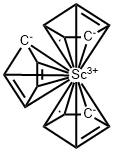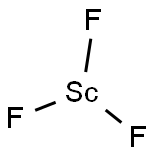SCANDIUM
Synonym(s):;Scandium
- CAS NO.:7440-20-2
- Empirical Formula: Sc
- Molecular Weight: 44.96
- MDL number: MFCD00016323
- EINECS: 231-129-2
- SAFETY DATA SHEET (SDS)
- Update Date: 2025-01-27 09:38:02

What is SCANDIUM?
Chemical properties
grey powder
Physical properties
Scandium is a soft, lightweight, silvery-white metal that does not tarnish in air, but overtime, it turns yellowish-pink. It resists corrosion. Scandium reacts vigorously with acids, butnot water. Scandium has some properties similar to the rare-earth elements. Although its position in group 3 places it at the head of the 17 elements of the lanthanide series of rare-earthmetals, scandium, as a metal, is not usually considered a rare-earth. Scandium’s melting pointis 1,541°C, its boiling point is 2836°C, and its density is 2.989 g/cm3.
Isotopes
There are 28 isotopes of scandium, ranging from scandium-36 to scandium-57.Scandium-45 is the only stable isotope and contains about 100% of the natural scandium found in the Earth’s crust. The remaining isotopes are radioactive with half-livesranging from nanoseconds to a few minutes to a few hours to a few days, and therefore,they are not found naturally in the Earth’s crust. The radioactive isotopes of scandiumare produced in nuclear reactors.
Origin of Name
From the Latin word Scandia, for “Scandinavia.
Occurrence
Although scandium is chemically similar to rare-earths, it no longer is considered to be oneof them. Scandium is the 42nd most abundant element found in the Earth’s crust, makingup about 0.0025% of the Earth’s crust. It is widely distributed at 5 ppm on the Earth. (It isabout as abundant as lithium, as listed in group 1.) Scandium is even more prevalent in thesun and several other stars than it is on Earth.Scandium is found in ores of wolframite in Norway and thortveitite in Madagascar. It isalso found in granite pegmatites and monazites. It is common in many of the ores where tinand tungsten are also found.
History
On the basis of the Periodic System, Mendeleev predicted the existence of ekaboron, which would have an atomic weight between 40 of calcium and 48 of titanium. Scandium was discovered by Nilson in 1878 in the minerals euxenite and gadolinite, which had not yet been found anywhere except in Scandinavia. By processing 10 kg of euxenite and other residues of rare-earth minerals, Nilson was able to prepare about 2 g of scandium oxide of high purity. Cleve later pointed out that Nilson’s scandium was identical with Mendeleev’s ekaboron. Scandium is apparently a much more abundant element in the sun and certain stars than here on Earth. It is about the 23rd most abundant element in the sun, compared to the 50th most abundant on Earth. It is widely distributed on Earth, occurring in very minute quantities in over 800 mineral species. The blue color of beryl (aquamarine variety) is said to be due to scandium. It occurs as a principal component in the rare mineral thortveitite, found in Scandinavia and Malagasy. It is also found in the residues remaining after the extraction of tungsten from Zinnwald wolframite, and in wiikite and bazzite. Most scandium is presently being recovered from thortveitite or is extracted as a by-product from uranium mill tailings. Metallic scandium was first prepared in 1937 by Fischer, Brunger, and Grieneisen, who electrolyzed a eutectic melt of potassium, lithium, and scandium chlorides at 700 to 800°C. Tungsten wire and a pool of molten zinc served as the electrodes in a graphite crucible. Pure scandium is now produced by reducing scandium fluoride with calcium metal. The production of the first pound of 99% pure scandium metal was announced in 1960. Scandium is a silver-white metal that develops a slightly yellowish or pinkish cast upon exposure to air. It is relatively soft, and resembles yttrium and the rare-earth metals more than it resembles aluminum or titanium. It is a very light metal and has a much higher melting point than aluminum, making it of interest to designers of spacecraft. Scandium is not attacked by a 1:1 mixture of conc. HNO3 and 48% HF. Scandium reacts rapidly with many acids. Twentythree isotopes and isomers of scandium are recognized. The metal is expensive, costing about $200/g with a purity of about 99.9%. About 20 kg of scandium (as Sc203) are now being used yearly in the U.S. to produce high-intensity lights, and the radioactive isotope 46Sc is used as a tracing agent in refinery crackers for crude oil, etc. Scandium iodide added to mercury vapor lamps produces a highly efficient light source resembling sunlight, which is important for indoor or night-time color TV. Little is yet known about the toxicity of scandium; therefore, it should be handled with care.
Characteristics
Scandium is the first element in the fourth period of the transition elements, which meansthat the number of protons in their nuclei increases across the period. As with all the transition elements, electrons in scandium are added to an incomplete inner shell rather than tothe outer valence shell as with most other elements. This characteristic of using electrons inan inner shell results in the number of valence electrons being similar for these transition elements although the transition elements may have different oxidation states. This is also whyall the transition elements exhibit similar chemical activity.
The Uses of SCANDIUM
Scandium was not produced in any quantities until the late 1930s. Its light weight,resistance to corrosion, and high melting point made it especially useful in the aerospaceindustries. In the early 1940s contractors for the U.S. Air Force appropriated almost all of thescandium metal for use in the construction of military aircraft. The pure metal form is produced by the electrolysis of a salt of scandium, ScCl3. The metal has found some other uses in high-intensity lamps that produce a natural spectrum, making it useful for stadium lighting.It is also used in nickel alkaline storage batteries. Several compounds are used as catalysts tospeed up chemical reactions. The radioactive scandium-46 (with a half-life of 83.8 days) emitsbeta radiation. This property makes it useful as a radioactive tracer in the petroleum industryto monitor fractionation products.
The Uses of SCANDIUM
It finds applications in the aerospace industry. Another use of Scandium is in aluminum-scandium alloys for sports equipment, such as bicycle frames, lacrosse sticks, and baseball bats.
Definition
A lightweight silvery element belonging to the first transition series. It is found in minute amounts in over 800 minerals, often associated with lanthanoids. Scandium is used in high-intensity lights and in electronic devices. Symbol: Sc; m.p. 1541°C; b.p. 2831°C; r.d. 2.989 (0°C); p.n. 21; r.a.m. 44.955910.
Definition
scandium: Symbol Sc. A rare softsilvery metallic element belonging togroup 3 (formerly IIIA) of the periodictable; a.n. 21; r.a.m. 44.956; r.d.2.989 (alpha form), 3.19 (beta form);m.p. 1541°C; b.p. 2831°C. Scandiumoften occurs in lanthanoid ores,from which it can be separated on accountof the greater solubility of itsthiocyanate in ether. The only naturalisotope, which is not radioactive,is scandium–45, and there are nineradioactive isotopes, all with relativelyshort half-lives. Because of themetal’s high reactivity and high costno substantial uses have been foundfor either the metal or its compounds.Predicted in 1869 by DmitriMendeleev, and then called ekaboron,the oxide (called scandia) wasisolated by Lars Nilson (1840–99) in1879.
Hazard
As with other metals, the transition metals and many of their compounds are toxic, andtheir powdered or gaseous forms should not be ingested or inhaled. In addition, all but one ofthe isotopes of scandium are radioactive and should be handled by experienced personnel.
Toxicity evaluation
Scandium is considered non-toxic, though extensive animal testing of scandium compounds has not been done.The median lethal dose (LD50) levels for scandium chloride for rats have been determined as 755 mg/kg for intraperitoneal and 4 g/kg for oral administration.Compounds of scandium should be handled as compounds of moderate toxicity.
Properties of SCANDIUM
| Melting point: | 1540 °C (lit.) |
| Boiling point: | 2836 °C (lit.) |
| Density | 2.99 g/mL at 25 °C (lit.) |
| solubility | Slowly dissolve in dilute acids. |
| form | powder |
| Specific Gravity | 3 |
| color | Silver-gray |
| Resistivity | 50.5 μΩ-cm, 0°C |
| Water Solubility | Reacts with water. |
| Sensitive | air sensitive |
| Merck | 13,8468 |
| Exposure limits | ACGIH: TWA 2 ppm; STEL 4 ppm OSHA: TWA 2 ppm(5 mg/m3) NIOSH: IDLH 25 ppm; TWA 2 ppm(5 mg/m3); STEL 4 ppm(10 mg/m3) |
| CAS DataBase Reference | 7440-20-2(CAS DataBase Reference) |
| EPA Substance Registry System | Scandium (7440-20-2) |
Safety information for SCANDIUM
| Signal word | Danger |
| Pictogram(s) |
 Flame Flammables GHS02 |
| GHS Hazard Statements |
H228:Flammable solids |
| Precautionary Statement Codes |
P210:Keep away from heat/sparks/open flames/hot surfaces. — No smoking. P240:Ground/bond container and receiving equipment. P241:Use explosion-proof electrical/ventilating/lighting/…/equipment. P280:Wear protective gloves/protective clothing/eye protection/face protection. P370+P378:In case of fire: Use … for extinction. |
Computed Descriptors for SCANDIUM
| InChIKey | SIXSYDAISGFNSX-UHFFFAOYSA-N |
New Products
4,4-Difluoropiperidine hydrochloride tert-butyl 9-methoxy-3-azaspiro[5.5]undecane-3-carboxylate Indole Methyl Resin N-Isopropylurea N,N-Dicyclohexylcarbodiimide(DCC) MELDRUMS ACID 5-METHYLISOXAZOLE-4-CARBOXYLIC ACID Magnessium Bis glycinate Zinc ascorbate 1-bromo-2-butyne 2-acetamidophenol 9(10H)-anthracenone Erythrosin B, 4-Piperidinopiperidine 2-((4-morpholinophenylamino) (methylthio) methylene) malononitrile 2,4-dihydroxybenzaldehyde 3-(4-morpholinophenylamino)-5-amino-1H-pyrazole-4-carbonitrile Methyl 2-methylquinoline-6-carboxylate 2,6-dichloro-4-nitropyridine 4-Bromo-2-chlorobenzonitrile 2-(benzylamino)acetic acid hydrochloride 4-(tert-Butoxycarbonylamino)but- 2-ynoic acid 3,4-dihydro-2H-benzo[b][1,4]dioxepine 1-Phenyl-1-cycloprppanecarboxylicacidRelated products of tetrahydrofuran








You may like
-
 Scandium, plasma standard solution CAS 7440-20-2View Details
Scandium, plasma standard solution CAS 7440-20-2View Details
7440-20-2 -
 Scandium, plasma standard solution CAS 7440-20-2View Details
Scandium, plasma standard solution CAS 7440-20-2View Details
7440-20-2 -
 Scandium, plasma standard solution CAS 7440-20-2View Details
Scandium, plasma standard solution CAS 7440-20-2View Details
7440-20-2 -
 Scandium ingot CAS 7440-20-2View Details
Scandium ingot CAS 7440-20-2View Details
7440-20-2 -
 Scandium CAS 7440-20-2View Details
Scandium CAS 7440-20-2View Details
7440-20-2 -
 Scandium CAS 7440-20-2View Details
Scandium CAS 7440-20-2View Details
7440-20-2 -
 Scandium, pieces CAS 7440-20-2View Details
Scandium, pieces CAS 7440-20-2View Details
7440-20-2 -
 Scandium ICP standard CASView Details
Scandium ICP standard CASView Details
